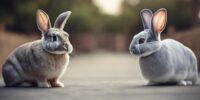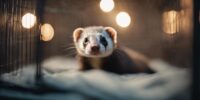Why the Rhinelander Rabbit's Markings Are So Distinctive
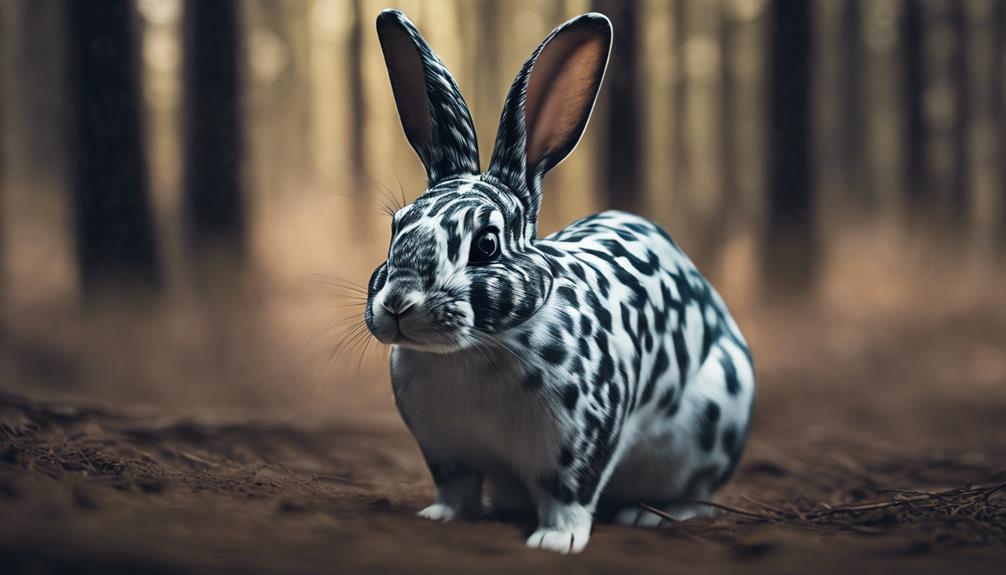
The breed's origins can be traced back to Germany, where breeders carefully selected rabbits with specific coat patterns to develop the Rhinelander Rabbit we know today.
The breed's popularity has spread worldwide, with many breeders dedicated to preserving and promoting this unique and beautiful rabbit breed.
Genetic Basis of Markings
Controlling the distinct markings of Rhinelander rabbits involves a complex interplay of specific color genes and patterns dictated by genetic traits. The butterfly markings on the face are a result of these genetic factors, determining the distribution and colors of the facial markings. Genetic variations play a crucial role in defining the placement and shape of markings like the butterfly on the nose and the colored spots on the cheeks and ears.
Understanding the genetic basis of Rhinelander rabbit markings is essential for breeders aiming to maintain the breed's standard appearance. By comprehending the specific color genes and patterns responsible for these markings, breeders can select appropriate breeding pairs to ensure the offspring exhibit the correct and distinctive markings characteristic of the Rhinelander rabbit breed. This genetic knowledge enables breeders to make informed decisions when pairing rabbits, ultimately preserving the unique and sought-after markings that define Rhinelander rabbits.
Historical Development of Markings
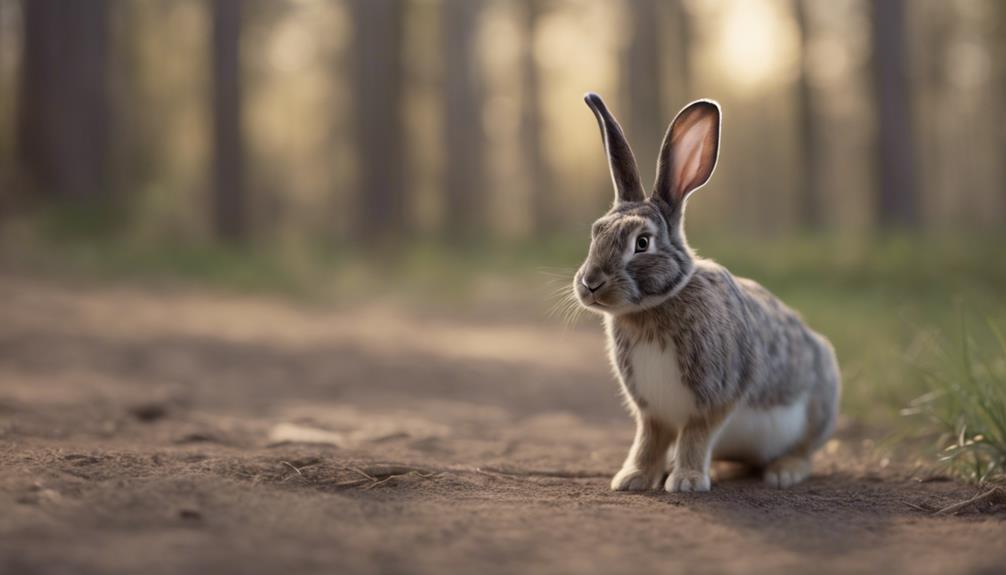
The historical development of the distinctive markings of Rhinelander Rabbits traces back to specific breeding methods employed in Germany during the early 20th century.
- Selective Breeding: Breeders in Germany carefully selected rabbits with desired markings, focusing on enhancing specific traits through controlled mating to achieve the characteristic butterfly markings on the face, saddle markings along the spine, and colored spots on the sides.
- Crossbreeding Techniques: The development of the Rhinelander Rabbit's markings involved strategic crosses between Harlequin and gray papillon type rabbits to introduce and stabilize the desired color patterns and distribution.
- Breed Standard Adherence: The breed standard for Rhinelander Rabbits outlines precise criteria for the balance, distribution, and quality of markings, guiding breeders in maintaining the unique appearance that distinguishes this breed from others.
Through the meticulous application of these breeding methods and adherence to the defined breed standard, the Rhinelander Rabbit's markings have evolved into a hallmark feature, contributing significantly to the breed's recognition and popularity.
Factors Influencing Marking Patterns
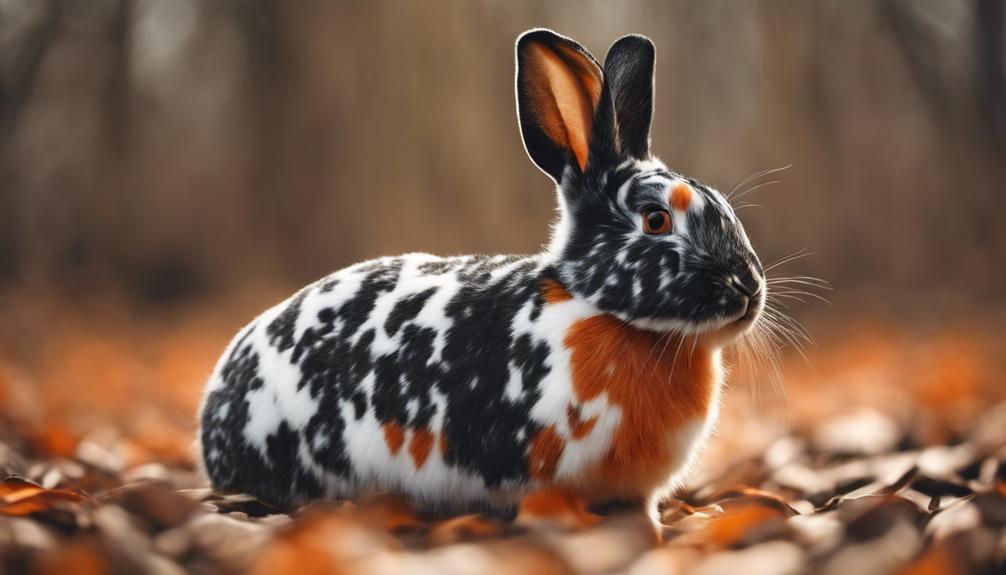
The distinctive markings of Rhinelander rabbits are determined by a complex interplay of genetic inheritance, environmental influences, and selective breeding practices.
Genetic factors play a crucial role in defining the specific color distribution and pattern requirements necessary for meeting breed standards.
Breeders carefully consider these influences to maintain and enhance the unique marking patterns that characterize the Rhinelander rabbit breed.
Genetic Inheritance Role
Genetic inheritance patterns intricately shape the distinctive markings of Rhinelander rabbits, influenced by factors such as gene expression, color genetics, and breeding practices.
- Gene Expression: Specific genes control how colors and patterns are distributed on the Rhinelander rabbit's coat, resulting in its unique markings.
- Color Genetics: The interplay of different genetic factors determines the color combinations and patterns that manifest in the rabbit's fur.
- Breeding Practices: Through selective breeding, breeders aim to preserve and enhance the desired marking patterns seen in Rhinelander rabbits, ensuring the continuation of these distinct traits in future generations.
These genetic elements interact in complex ways, contributing to the iconic appearance of the Rhinelander rabbit.
Environmental Influences Impact
Influences from the environment, such as diet, stress levels, and living conditions, can significantly impact the expression and intensity of the distinctive markings found in Rhinelander rabbits. Alongside genetic factors and breeding techniques, these environmental factors play a crucial role in shaping the coloration and patterns of these rabbits.
The interplay between specific genes responsible for coloration and pattern development is modulated by environmental cues, contributing to the unique appearance of Rhinelander rabbits. Selective breeding practices have further honed these characteristics over time, leading to the consistent and striking butterfly markings, saddle markings, and side patches that define the breed.
Selective Breeding Effects
Through targeted breeding practices, breeders strategically enhance and emphasize specific color patterns in Rhinelander rabbits to accentuate their distinctive markings.
Selective breeding in Rhinelander rabbits influences the distinctiveness of their markings by emphasizing specific color patterns.
Factors like gene expression and inheritance play a role in determining the unique marking patterns of Rhinelander rabbits.
Controlled breeding practices over generations have resulted in the consistent and recognizable facial butterfly markings and spine marking in Rhinelander rabbits.
This intentional breeding for specific markings has led to the development of a standardized appearance in Rhinelander rabbits, ensuring that their color distribution and symmetry meet the breed standard, setting them apart from other rabbit breeds.
Comparison With Other Rabbit Breeds
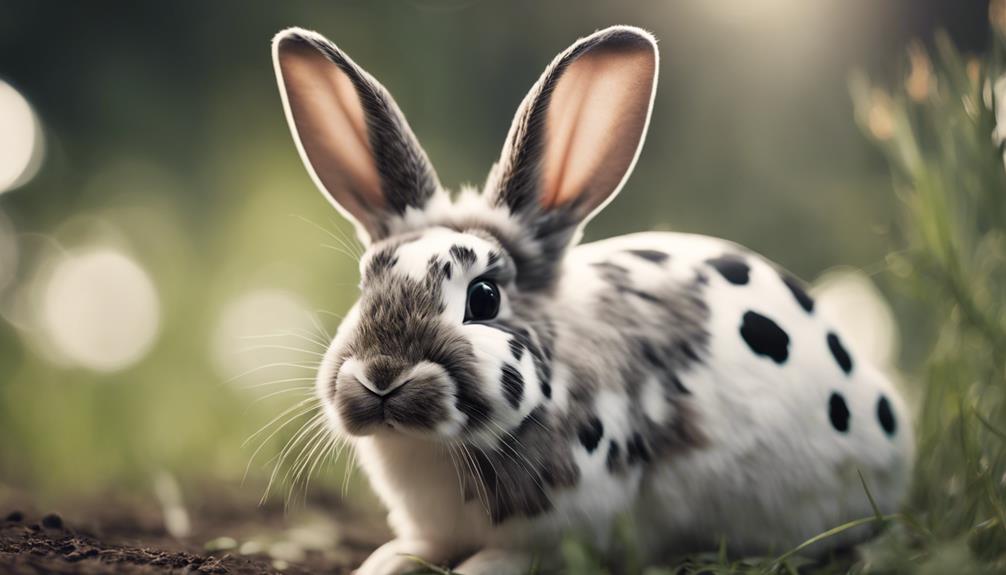
Rhinelander rabbits display unique color patterns that set them apart from other rabbit breeds. While some breeds may have spots or patches, Rhinelanders have specific color distributions in their markings.
The distinct spine marking of Rhinelander rabbits widens and narrows in a way that distinguishes them from other breeds.
Unique Color Patterns
Distinctive color patterns distinguish Rhinelander rabbits from other breeds, showcasing butterfly markings, colored ears, cheek spots, and spine markings.
- Rhinelander rabbits exhibit a unique color pattern with butterfly markings on their face, adding a touch of elegance to their appearance.
- The colored ears of Rhinelander rabbits contribute to their distinctiveness, creating a contrast that enhances their overall aesthetic appeal.
- The spine marking of Rhinelander rabbits, starting wide at the shoulders and tapering towards the tail base, sets them apart from other breeds, giving them a refined and sophisticated look.
These unique color patterns make Rhinelander rabbits stand out in competitions, emphasizing the breed's exceptional beauty and individuality.
Breeds With Spots
Breeds with spotted markings exhibit unique color patterns that distinguish them from other rabbit breeds. Among these breeds, the Rhinelander rabbit stands out with its distinct butterfly pattern on the face and evenly distributed spots in two colors along its sides.
The color distribution on Rhinelanders is precise, with specific markings required for meeting show standards. Unlike some other breeds with spots, Rhinelanders have a combination of black and yellow or fawn and blue markings on a white base coat, making them easily recognizable.
This specific coloration sets them apart from other breeds that may have more irregular or varied spot patterns, highlighting the importance of the Rhinelander's markings in defining its breed standard.
Markings in Rabbits
Spotted markings in rabbits vary significantly across different breeds, showcasing a wide range of color patterns and distributions. When comparing these markings with the unique characteristics of Rhinelander rabbits, some key differences emerge:
- Uniqueness: The markings on Rhinelander rabbits, such as the butterfly pattern on their face and spine marking, set them apart from other breeds.
- Balance: Unlike some breeds with scattered spots, Rhinelander rabbits have a specific balance and distribution of markings that contribute to their distinct appearance.
- Spine Marking: The spine marking in Rhinelanders is a defining feature, narrowing at the neck and tail base, adding to the breed's unique and recognizable characteristics.
Unique Features of Rhinelander Rabbit's Coat
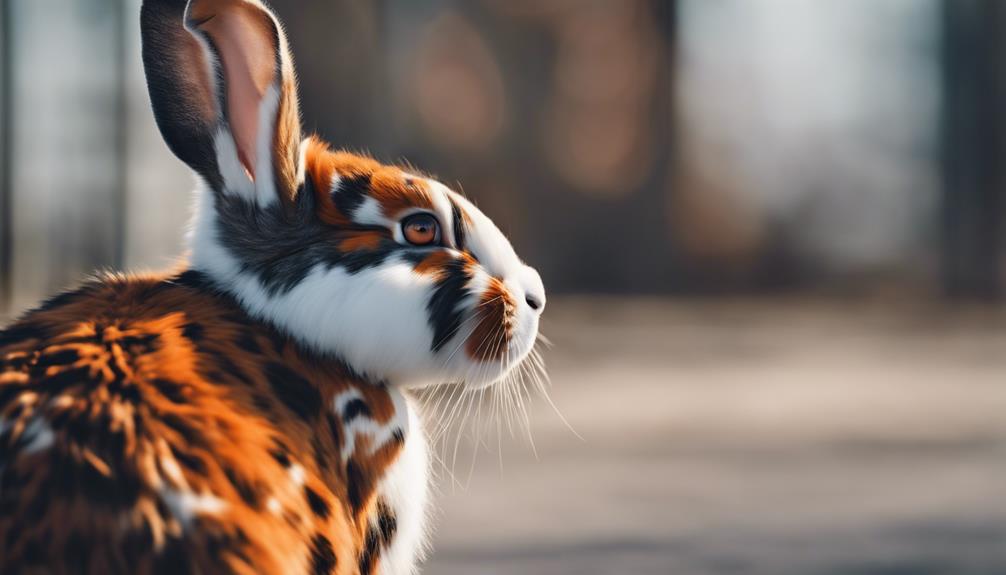
Rhinelander rabbits exhibit a unique coat pattern characterized by butterfly markings on their faces, colored ears, cheek spots, eye circles, and specific side markings. The butterfly markings are distinctive, consisting of two colors on a white base coat, creating a striking visual contrast.
Additionally, these rabbits have colored ears, cheek spots, and eye circles, further enhancing their individuality. The side markings, typically comprising 6-8 evenly distributed spots in two colors, contribute significantly to the overall distinctiveness of the breed.
Moreover, the spine markings that narrow at the neck and tail base add to the unique appearance of Rhinelander rabbits. This combination of specific markings, color distribution, and pattern variations makes Rhinelander rabbits easily recognizable and visually appealing.
The intricate details of their coat not only make them stand out but also showcase the careful breeding and genetic selection that have gone into developing this particular breed.
Breeding Strategies for Marking Perfection
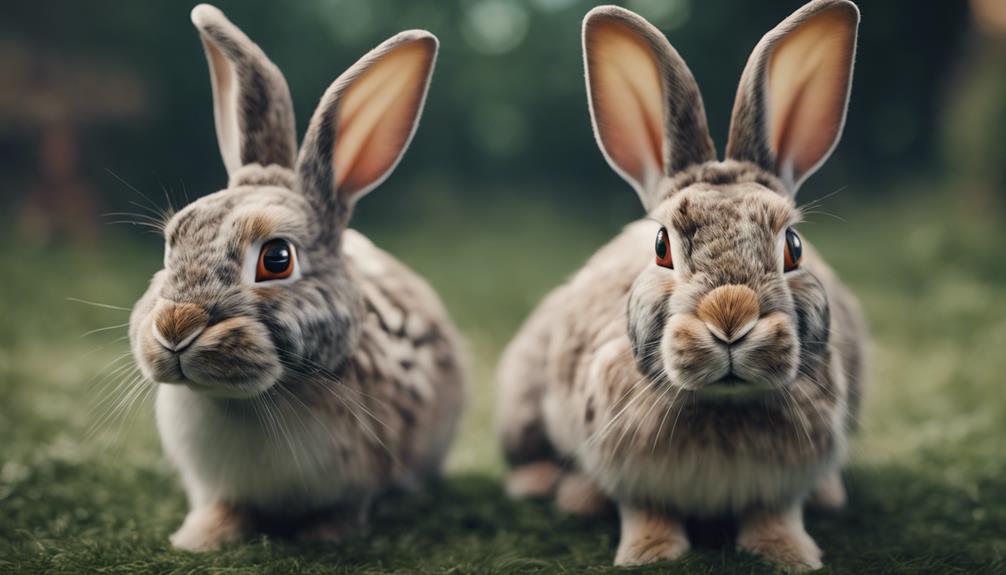
In the pursuit of perfection in marking qualities, breeders of Rhinelander rabbits meticulously select breeding pairs to refine the clarity and balance of distinct two-color markings on the rabbits' faces and bodies.
Breeding Strategies for Marking Perfection:
- Selecting for precise butterfly outlines and saddle markings is crucial to ensure the desired symmetrical and well-defined patterns on the Rhinelander Rabbit's coat.
- Breeders focus on enhancing the clarity of markings by choosing specific breeding pairs that exhibit the ideal distribution of spots and color balance on the rabbit's face and body.
- Avoiding faults such as ragged edges, stray spots, or incomplete eye circles is essential in maintaining the uniformity and quality of the markings, ensuring they meet the breed standard for perfection.
Maintenance and Care of Distinctive Markings

To maintain the distinct markings of Rhinelander rabbits, meticulous grooming practices are essential for preserving the clarity and vibrancy of the unique patterns on their coat. Regular grooming routines, such as weekly brushing, are crucial to prevent matting and preserve the intricate markings that define the breed standard. Careful handling during grooming is necessary to avoid smudging or fading of the markings, as the color contrast plays a significant role in the rabbit's appearance. Providing a clean and dry living environment further safeguards against dulling of the markings by preventing dirt and debris accumulation. Monitoring for any changes in the markings, such as fading or smudging, is vital as it can signal underlying health issues or the need for adjustments in grooming or care routines.
| Importance of Grooming | |
|---|---|
| Prevents matting | Preserves breed standard |
| Maintains color contrast | Ensures clarity of markings |
| Prevents smudging | Indicates overall health |
Frequently Asked Questions
What Are the Markings of a Rhinelander Rabbit?
The markings of a Rhinelander rabbit are a masterpiece of nature. Their butterfly patterns, saddle markings, and distinct patches showcase precise color genetics. Breeding techniques have honed their coat texture, making them stand out in show competitions.
What Is the Standard of Perfection for Rhinelander Rabbits?
The Standard of Perfection for Rhinelander rabbits establishes breeding requirements and show standards. It dictates genetic inheritance, color variations, and fur texture. Adhering strictly to this standard ensures the preservation of the breed's distinctive markings and overall quality.
What Is the History of the Rhinelander Rabbit?
The Rhinelander Rabbit's history dates back to Germany in 1902, introduced to the U.S. in 1923, disappearing and then revived in 1972. Originating in Grevenbroch, Josef Heinz meticulously bred this breed known for distinct markings.
What Are the Distinguishing Features of Rabbit?
The Rhinelander rabbit stands out due to its unique patterns, color combinations, and recognizable traits. Genetic variations contribute to their distinctive appearance. Breeding techniques are crucial to maintain the breed's specific markings and standards.

